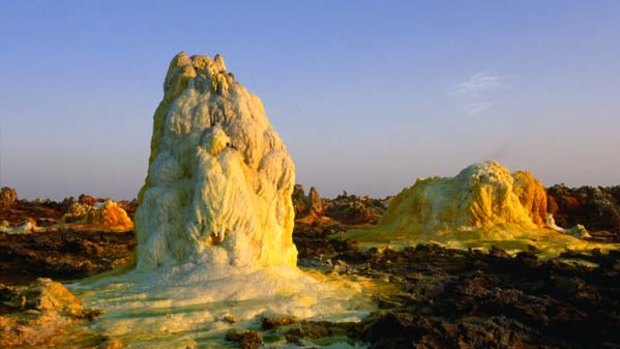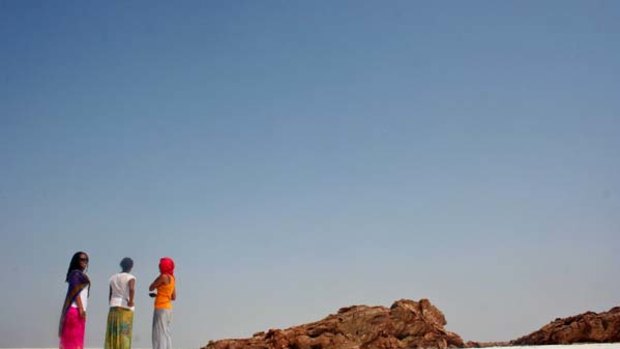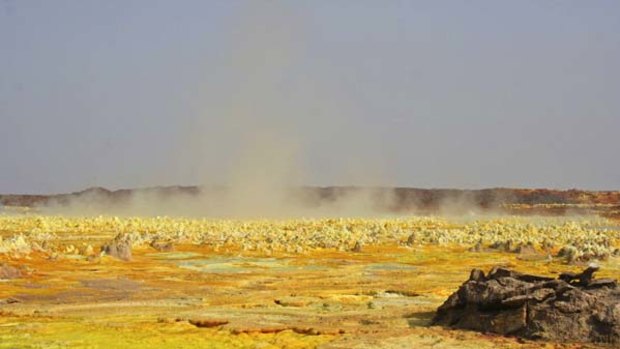By Barry Malone

Ethiopia's Danakil Depression - the hottest place on the planet with an average annual temperature of 34.4 Celsius.Credit: Ariadne Van Zandbergen/Lonely Planet
I turn to my girlfriend, barely able to see her through the sweat that stings my eyes. "I know how this sounds," I say. "But is my head still the same size?"
The evening before, we had arrived at a remote, nomad settlement, one hour from Ethiopia's Danakil Depression - the hottest place on the planet with an average annual temperature of 34.4 Celsius.
As we stand looking over a sea of rocks to salt plains that shimmer white in the distance, our guide tells us the heat here has risen as high as 67 degrees Celsius.

The Danakil is a tectonic triple-junction where the spreading ridges that form the Red Sea and the Gulf of Aden emerge on land and meet Africa's Great Rift Valley.Credit: Reuters
"For you tomorrow, only 47," he assures us.
The Danakil is a tectonic triple-junction where the spreading ridges that form the Red Sea and the Gulf of Aden emerge on land and meet Africa's Great Rift Valley.
It is still being slowly but surely pulled apart at the rate of about 1 to 2 cm a year and some scientists say we are standing on the site of what, 10 million years from now, will be a new ocean that splits the African continent in two.

The landscape is a mixture of brilliant yellows and oranges and blues. Just 500 tourists visit it each year.Credit: Reuters
Our hosts for the night -- local Afar tribesmen -- bring us straw beds for which they charge a dollar each. We are to sleep out in the open, without cover of any kind; the breeze necessary to keep us cool, our only ceiling the sky above.
But when the wind comes, it is like being blown in the face by a hot hairdryer. Afar men linger nearby and seem much friendlier these days than when they were among the most feared tribesmen in the world, famed for lopping off the testicles of foreigners and wearing them as trophies on necessarily long necklaces.
Our village home for the night, Hamedela, is the place from where five foreign tourists were snatched in 2007 and taken over the Eritrean border for 12 days.
Still, with a military base now nearby, we sleep easily after our morning flight from Addis Ababa to the town of Mekele and an eight-hour drive from there.
A sound wakes me during the night and I roll over. A camel and a donkey -- the former chasing the latter -- gallop at full tilt through our camp. I turn to my friends. They are all asleep. I look up at the moon and shut my eyes.
SIZZLING SULPHUR
We wake at 5:30 a.m. the next morning and, after eating some local pancakes, climb into our two 4X4s and begin our descent to 120 metres below sea level.
Four Ethiopian soldiers armed with AK-47s come along with us for protection -- one perched up on the roof of one car, scanning the horizon for bandits.
Tremendous heat consumes us immediately when we arrive at the rocky hill we must walk up to reach the Danakil's famously ethereal sulphur and salt lakes.
We have decided we are not hardy enough to spend the extra two days it would take to reach Dabbahu -- the Danakil's still very active volcano.
"Ten minutes only," says our guide.
Thirty-five trudging -- but spectacular -- minutes later we arrive, the two Irishmen in our group unsurprisingly suffering significantly more than the four Ethiopians.
I am drenched with sweat. I can barely speak. My head tingles and my body starts to flush cold. I realise coming hungover to the Danakil after three days of partying in Addis Ababa was a bad idea.
But it is magnificent. And we are among just 500 tourists a year who see it.
The landscape is a mixture of brilliant yellows and oranges and blues. And it lives.
It sizzles, it steams, it whispers. Sulphur bubbles up everywhere. We take photos, we protect our noses from the noxious odours, we soak it all in.
But we must move quickly. Staying too long in the Danakil is treacherous. Our guide tells us that a French woman disappeared here some years ago and, when her remains were finally found, all that was left was bones.
"Was she travelling alone?" I ask.
"Oh, no," he says, cheerily. "She was in a guided tour exactly like this one."
As we drive away over the salt plains, I try to ignore the mild hallucinations I am experiencing and think about the next leg of our holiday, the eco lodge we are headed to and our planned highland trek in this beautiful, diverse country.
We wind slowly back up into the green hills, the air cools, we are all silent.
Reuters
Sign up for the Traveller Deals newsletter
Get exclusive travel deals delivered straight to your inbox. Sign up now.